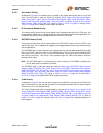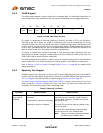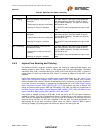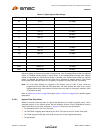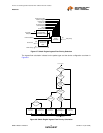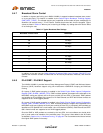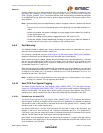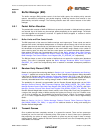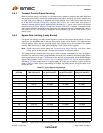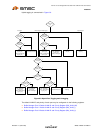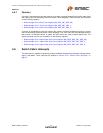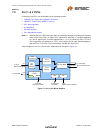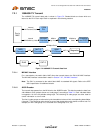
Two Port 10/100 Managed Ethernet Switch with 16-Bit Non-PCI CPU Interface
Datasheet
SMSC LAN9311/LAN9311i 77 Revision 1.4 (08-19-08)
DATASHEET
6.5 Buffer Manager (BM)
The buffer manager (BM) provides control of the free buffer space, the multiple priority transmit
queues, transmission scheduling, and packet dropping. VLAN tag insertion and removal is also
performed by the buffer manager. The following sections detail the various features of the buffer
manager.
6.5.1 Packet Buffer Allocation
The packet buffer consists of 32KB of RAM that is dynamically allocated in 128 byte blocks as packets
are received. Up to 16 blocks may be used per packet, depending on the packet length. The blocks
are linked together as the packet is received. If a packet is filtered, dropped, or contains a receive
error, the buffers are reclaimed.
6.5.1.1 Buffer Limits and Flow Control Levels
The BM keeps track of the amount of buffers used per each ingress port. These counts are used to
generate flow control (half-duplex backpressure or full-duplex pause frames) and to limit the amount
of buffer space that can be used by any individual receiver (hard drop limit). The flow control and drop
limit thresholds are dynamic and adapt based on the current buffer usage. Based on the number of
active receiving ports, the drop level and flow control pause and resume thresholds adjust between
fixed settings and two user programmable levels via the Buffer Manager Drop Level Register
(BM_DROP_LVL), Buffer Manager Flow Control Pause Level Register (BM_FC_PAUSE_LVL), and
Buffer Manager Flow Control Resume Level Register (BM_FC_RESUME_LVL) respectively.
The BM also keeps a count of the number of buffers that are queued for multiple ports (broadcast
queue). This count is compared against the Buffer Manager Broadcast Buffer Level Register
(BM_BCST_LVL), and if the configured drop level is reached or exceeded, subsequent packets are
dropped.
6.5.2 Random Early Discard (RED)
Based on the ingress flow monitoring detailed in Section 6.4.6, "Ingress Flow Metering and Coloring,"
on page 71, packets are colored as Green, Yellow, or Red. Packets colored Red are always discarded
if the Drop on Red bit in the Buffer Manager Configuration Register (BM_CFG) is set. If the Drop on
Yellow bit in the Buffer Manager Configuration Register (BM_CFG) is set, packets colored Yellow are
randomly discarded based on the moving average number of buffers used by the ingress port.
The probability of a discard is programmable into the Random Discard Weight table via the Buffer
Manager Random Discard Table Command Register (BM_RNDM_DSCRD_TBL_CMD), Buffer
Manager Random Discard Table Write Data Register (BM_RNDM_DSCRD_TBL_WDATA), and Buffer
Manager Random Discard Table Read Data Register (BM_RNDM_DSCRD_TBL_RDATA). The
Random Discard Weight table contains sixteen entries, each 10-bits wide. Each entry corresponds to
a range of the average number of buffers used by the ingress port. Entry 0 is for 0 to 15 buffers, entry
1 is for 16 to 31 buffers, etc. The probability for each entry us set in 1/1024’s. For example, a setting
of 1 is 1-in-1024, or approximately 0.1%. A setting of all ones (1023) is 1023-in-1024, or approximately
99.9%.
Refer to Section 14.5.4.10, "Buffer Manager Random Discard Table Command Register
(BM_RNDM_DSCRD_TBL_CMD)," on page 422 for additional details on writing and reading the
Random Discard Weight table.
6.5.3 Transmit Queues
Once a packet has been completely received, it is queued for transmit. There are four queues per
transmit port, one for each level of transmit priority. Each queue is virtual (if there are no packets for
that port/priority, the queue is empty), and dynamic (a queue may be any length if there is enough
memory space). When a packet is read from the memory and sent out to the corresponding port, the
used buffers are released.



